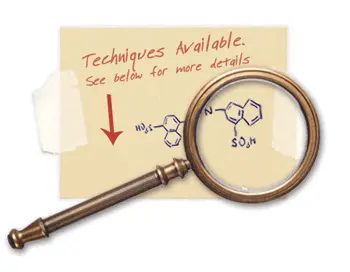Physical chemistry testing is carried out to attain regulatory compliance and can also be used for the purposes of research and development, product development, and technical support.
Our lab is fully equipped to help you demonstrate control and consistency. We offer the following services:Physico-chemical measurements available:
- Boiling Point
- Conductivity
- Density
- Freezing Point
- logD
- logP
- Melting Point
- Optical Rotation
- pH
- Redox potential
- Refractive Index
- Stability
- Viscosity
Additional physico-chemical test measurements:
- Crystallinity
- Flowability
- MW determination for polymers
- Particle size
- Resistivity
- Solubility in organic solvents
- Stability in organic solvents
- Storage stability
- Thermal stability
- Wettability
These tests can be used to provide technical data such as identity, purity, impurity profile:
- Elemental Microanalysis (Carbon, Oxygen, Hydrogen, Nitrogen, Sulphur / CHNS)
- Gas Chromatography - Mass Spectrometry (GC-MS)
- High Performance Liquid Chromatography (HPLC, LC/MS and LC/MS/MS detection)
- Spectroscopy (FT-IR, IR, RAMAN)
- Mass Spectrometry (MS)
- Metals Analysis by Inductively Coupled Plasma Spectroscopy (ICP)
- Nuclear Magnetic Resonance Spectroscopy (NMR)
- Powder X-ray Diffraction (XRD)
- Thermal Analysis (TGA, DSC)
- Ultraviolet and Visible Absorption Spectroscopy (UV/vis)
- Water content by Karl-Fischer and Dynamic Vapor Sorption
- X-Ray Fluorescence (XRF)
The characteristics that enable us to distinguish one substance from another are called properties. A physical property is a characteristic of matter that is not associated with a change in its chemical composition. Familiar examples of physical properties include density, color, hardness, melting, and boiling points, and electrical conductivity. We can observe some physical properties, such as density and color, without changing the physical state of the matter observed. Other physical properties, such as the melting temperature of iron or the freezing temperature of water, can only be observed as matter undergoes a physical change. A physical change is a change in the state or properties of matter without any accompanying change in its chemical composition. We observe a physical change when wax melts, when sugar dissolves in coffee, and when steam condenses into liquid water Other examples of physical changes include magnetizing and demagnetizing metals (as is done with common anti-theft security tags) and grinding solids into powders (which can sometimes yield noticeable changes in color and consistency). In each of these examples, there is a change in the physical state, form, or properties of the substance, but no change in its chemical composition.
The change of one type of matter into another type (or the inability to change) is a chemical property. Examples of chemical properties include flammability, toxicity, acidity, reactivity (many types), and heat of combustion. Iron, for example, combines with oxygen in the presence of water to form rust; chromium does not oxidize. Nitroglycerin is very dangerous because it explodes easily due to chemical reactivity; neon poses almost no hazard because it is very unreactive.
Please see below for more detailed descriptions of the tests available at Triclinic Labs.
Ask Our Scientists!
Request More Info

pH
pH compares the acidity or alkalinity of a solution at a given temperature. A pH of 7 describes a neutral solution because the activities of hydrogen and hydroxide ions are equal. When the pH is below 7, the solution is described as acidic—the hydrogen ion activity increases and the pH value decreases. When the pH is above 7, the solution is described as basic (or alkaline)—the activity of hydroxide ion is greater than that of hydrogen ion.pH electrode measurements are made by comparing the readings in a sample with the readings in standards whose pH has been defined (buffers). pH meters contain pH versus temperature values for commonly used buffers. This allows the meter to recognize a particular pH buffer and calibrate with the correct buffer value at the measured temperature.
pKa
The pKa value is one method used to indicate the strength of an acid. pKa is the negative log of the acid dissociation constant or Ka value. A lower pKa value indicates a stronger acid. That is, the lower value indicates the acid more fully dissociates in water. The stronger an acid, the greater the ionization, the lower the pKa, and the lower the pH the compound will produce in solution.It is important to realize that pKa is not at all the same thing as pH: the former is an inherent property of a compound or functional group, while the latter is the measure of the hydronium ion concentration in a particular aqueous solution
LogP
LogP is used in the pharmaceutical/biotech industries to understand the behavior of drug molecules in the body. Drug candidates are often screened according to logP, among other criteria, to help guide drug selection and analog optimization. This is because lipophilicity is a major determining factor in a compound’s absorption, distribution in the body, penetration across vital membranes and biological barriers, metabolism and excretion (ADME properties). According to ‘Lipinski’s Rule of 5’ (developed at Pfizer) the logP of a compound intended for oral administration should be <5.A more lipophilic compound:
- Will have low aqueous solubility, compromising bioavailability. If an adequate concentration of a drug cannot be reached or maintained, even the most potent in-vitro substance cannot be an effective drug.
- May be sequestered by fatty tissue and therefore difficult to excrete; in turn leading to accumulation that will impact the systemic toxicity of the substance.
- May not be ideal for penetration through certain barriers. A drug targeting the central nervous system (CNS) should ideally have a logP value around 2;2 for oral and intestinal absorption the idea value is 1.35-1.8, while a drug intended for sub-lingual absorption should have a logP value <5.
Ion selective electodes:
We are able to measure the following:Calcium: LOD 0.4 ppm
Potassium: LOD 0.4 ppm
Sodium: LOD 0.02 ppm
Chloride: LOD 1 ppm
Ammonium: LOD 0.1 ppm
Sample requirements:
Samples must be water soluble, at least 1mg/mL. We cannot add organics to help dissolve the sample. The amount of material needed will vary. In cases where the ion content is high, we won’t need as much. In cases where ion content is low, we will need more. Generally speaking, approximately 50mg.
Other ISE measurements available available:bromide, copper, cyanide, iodide, lead, cadmium, perchlorate, nitrate, silver, sulfide, carbonate, fluoride
Elemental Analysis -
Determine elemental and isotopic composition
| Application AND Technique Description | ||
|---|---|---|
|
Elemental analysis is a qualitative and quantitative process for identifying the elemental composition of
materials (e.g., chemical compounds, minerals, metals, fluids). Certain elemental techniques can even
identify the isotopes of a given element.
We offer several techniques: Energy Dispersive X-ray - (EDX) is a rapid technique for identifying the elements from beryllium to uranium in solid materials. EDX uses an electron beam to stimulate the emission of characteristic x-rays of the elements from the sample surface. The elemental results are presented in an x-ray spectrum. EDX can be used to analyze localized areas or generate chemical maps. Both qualitative and quantitative analyses can be performed. (Triclinic Labs typically uses EDX for the identification of contaminants.) Inductively coupled plasma mass spectrometry (ICP- MS) is a highly sensitive technique used to detect trace elements within solid and liquid samples. ICP - MS works by dissolving the sample in an acid solution before ionizing it with inductively coupled plasma and then using the mass spectrometer to separate and identify the resulting ions and . Because the technique can identify elements at concentrations as low as parts per trillion, ICP-MS is useful in determining elemental impurities for most elements on the periodic table (excluding halogens) and can be used in USP <232> and <233> testing. Proton Induced X-Ray Emission (PIXE) is a non-destructive technique that can identify elements from sodium to uranium in solids, liquids, and aerosol filters. It uses a proton beam to excite an electron shell change to force the emission of detectable X-rays. PIXE can be used to analyze multi-element samples because each element’s X-rays are characteristic of the element and do not overlap with each other. -High Sensitivity (detection limit ~1 ppm for thin foils and ~10 ppm for thick samples) -Measurement at Atmospheric Pressure Possible (by allowing the beam to exit from the beam line through a thin window, large samples may be analyzed in air). -Multi-element Capability (major elemental analysis is performed for any element from sodium to uranium in a single spectrum ) -Non-destructive (minimal beam induced effects on the specimen) -Surface sensitive method (typical analysis depth is on the order of 1 µm) |
||
| Instrument Brand | Model | Notes |
| Various |
 GMP Testing Available |
|
Dissolution Testing -
Bioavailablity Assessment
| Application AND Technique Description | ||
|---|---|---|
|
Used to provide critical in vitro drug release information for both quality control purposes,
i.e., to assess batch-to-batch consistency of solid oral dosage forms such as tablets, and
drug development, i.e., to predict in vivo drug release profiles.
Several dissolution apparatuses exist. In the United States Pharmacopoeia (USP) General Chapter <711> Dissolution, there are four dissolution apparatuses standardized and specified. They are: USP Dissolution Apparatus 1 - Basket (37 °C) USP Dissolution Apparatus 2 - Paddle (37°C) USP Dissolution Apparatus 3 - Reciprocating Cylinder (37 °C) USP Dissolution Apparatus 4 - Flow-Through Cell (37 °C) The vessels of the dissolution method are usually either partially immersed in a water bath solution or heated by a jacket. An apparatus is used in solution within the vessels for a predetermined amount of time which depends on the method for the particular drug. The dissolution medium within the vessels is heated to 37°C with an acceptable difference of ± 0.5°C. ample solutions collected from dissolution testing are commonly analyzed by HPLC or Ultraviolet-visible spectroscopy for particular release statistics. |
||
| Instrument Brand | Model | Notes |
| Van Kel |
VF750D with UV/VIS or HPLC detection
 GMP Testing Available |
Wiki Reference for Dissolution Testing
|
Polarimeter -
Purity assessment of mixtures using
optical rotation
| Application AND Technique Description | ||
|---|---|---|
|
Polarimetry using Polarimeters measures the degree of rotation of polarized light as it passes through an
optically active material. Optical activity is a property unique to chiral substances. When the d and l
isomers are present in exactly equal concentrations they are still chiral, but their rotations cancel out
and the sample is referred to as a racemate or racemic mixture.
More relevant to industry are observed rotations of mixtures, for example of food ingredients, perfumes, flavorings, chemicals, pure or formulated pharmaceuticals - virtually any industry that produces or uses chiral organic molecules in pure or diluted form. In these situations, polarimetry provides a rapid, reliable, quality check that eliminates the need of using conventional analysis like liquid chromatography which can take an hour to do what the polarimeter accomplishes in minutes. Polarimetry provides an additional check on a pure substance before it is added to an expensive manufactured batch of materials to determine the ingredient's concentration or purity. |
||
| Instrument Brand | Model and Software | Notes |
| Rudolph |
Autopol V Plus
Embedded Polarimeter Software 3.2.6.1006  GMP Testing Available |
Wiki Reference for Polarimetry
|
Powder Wetability Force Tensiometer -
Determine Contact Angle
| Application AND Technique Description | ||
|---|---|---|
|
The contact angle is the angle, conventionally measured through the liquid, where a liquid-vapor
interface meets a solid surface. It quantifies the wettability of a solid surface by a liquid via the Young equation.
Surface roughness has a strong effect on the contact angle and wettability of a surface. The advancing contact angle can be described as a measure of the liquid-solid cohesion while the receding contact angle is a measure of liquid-solid adhesion. The advancing and receding contact angles can be measured directly using different methods and can also be calculated from other wetting measurements such as force tensiometery (aka Wilhemy-Plate method). Generally, if the water contact angle is smaller than 90°, the solid surface is considered hydrophilic and if the water contact angle is larger than 90°, the solid surface is considered hydrophobic. Many polymers exhibit hydrophobic surfaces. Highly hydrophobic surfaces made of low surface energy (e.g. fluorinated) materials may have water contact angles as high as ~120°. Some materials with highly rough surfaces may have a water contact angle even greater than 150°, due to the presence of air pockets under the liquid drop. These are called superhydrophobic surfaces. |
||
| Instrument Brand | Model and Software | References |
| Ramehart |
Ramehart Imaging System
Drop Image Advanced Software Version 1.4.11 Automated Dispensing System |
Wiki Reference for Contact Angle |
Disintegration Testing -
Quality control of drug product
| Application AND Technique Description | ||
|---|---|---|
| Before a tablet/hard gelatin capsule can dissolve and allow the active drug to be absorbed into the body, it must first disintegrate into smaller particles. The current apparatus described in the Pharmacopoeias (e.g. <USP Chapter 701>) was designed to provide a reproducible and standardized method of ensuring that disintegration has taken place. Drug products to be tested are placed in one of 6 vertical tubes arranged in a circular basket arrangement. The lower end of the tubes is covered by a sieve mesh. During testing, the basket assembly is raised and lowered in simulated gastric fluid at 37 degrees C and the tablet is continually “hammered” by a plastic disk of defined proportions to simulate in vivo conditions. The drug product is said to pass the disintegration test if no residue remains on the mesh after the designated test period. | ||
| Instrument Brand | Model | References |
| Testerion | DT2 | Wiki Reference for Disintegration Testing |
Hall Flow Rate Testing -
Powder flow rate and density
| Application AND Technique Description | ||
|---|---|---|
| This technique determines both flow rate and apparent density. It is applicable to both free-flowing metallic powders and other fine powders testing. The testing is performed with a calibrated hall flowmeter funnel according to International Standards. | ||
| Instrument Brand | Model | References |
| Hall FlowMeter | AS-300 | Powder metallurgy, metallic powders, food powders, cement powders, plastic powders, rubber powders, ceramic powders, pharmaceutical powders, foundry, casting, metalworking. |
Physical Chemistry Testing Service Levels Available:

